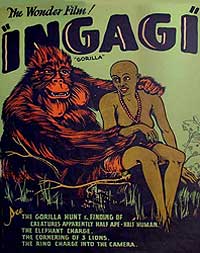 Ingagi (1931) was an ultra-low-budget exploitation film that was a financial success after it was promoted as a true story of the Congo.
Ingagi (1931) was an ultra-low-budget exploitation film that was a financial success after it was promoted as a true story of the Congo.
In a prologue to the faux documentary, a serious-seeming British chap, Sir Hubert Winstead, insured the audience that everything they are about to see is real. Sir Hubert turned out to be a fictional character, as also the American hunter Captain Swayne.
Despite that it was not the least convincing, & was filmed grainilly in southern California, mixed with stock footage of Africa, mostly recycled pieces of Lady Mackenzie's feature-length silent documentary of her journey into Kenya, Heart of Africa (1915).
As an aside, Heart of Africa had had hoaxy bits to it as well, beginning with jungle explorer & big game hunter Lady Mackenzie having made up her title.
The public instantly bought Ingaki as real. Critics treated the film surprisingly well with only a few doubting its authenticity.
It was extremely racist as well. An uncredited actress toward film's end is showing a lot more flesh that was permitted, because the guise of "ethnographic" always permitted aboriginal women to be shown in the altogether, seeing as how the dominant cultural still believes such people are more animal than are civilized humans.
Hence children denied access to nudie magazines by their parents are eagerly given copies of National Geographic with plenty of nekkid ladies & dangling dugs -- cuz hay, nobody expects animals to wear clothes.
It is strongly intimated in Ingagi that Congo women can get impregnated by gorillas & make love to them with great eagerness, making this film a world classic among zoophiliacs.
The infant shown is just a black child with a few tufts of hair glued onto him. The narrator says this black baby is more ape than human. Too damned bad white folks really thought like that, so that the more obviously unreal the film became, the more eager the public was to believe all of it.
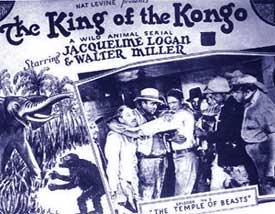 The film remains famous as hoax, though it's hard to understand how anyone could've been so supremely guillible. The film remains famous as hoax, though it's hard to understand how anyone could've been so supremely guillible.
The thematic material was commonplace in adventure novels of the late 1900s, & thus in early cinema.
The African adventure novels of H. Ridger Haggard such as King Solomon's Mines popularized the idea of meat-eating killer gorillas as a race distinct from the gentle vegetarians that actually exist, & this theme was taken up by scores of Haggard imitators, including Edgar Rice Burroughs for his Tarzan books.
Thus in Johnny Weismiller's first film Tarzan of the Apes (1932) we encounter an African tribe of white dwarfs in blackface who worship a giant gorilla.
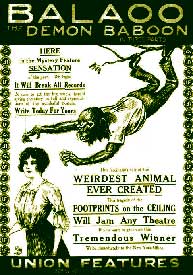 For gorillas rampaging in cities, we first had Poe's short story "The Murders in Rue Morgue," which inspired William Leroux's international bestselling novel Balaoo which was filmed as the twenty-minute Balaoo the Demon Baboon (Balaoo ou Des pas au plafond, 1913), instigating a slug of ape-kidnaps-girl movies. For gorillas rampaging in cities, we first had Poe's short story "The Murders in Rue Morgue," which inspired William Leroux's international bestselling novel Balaoo which was filmed as the twenty-minute Balaoo the Demon Baboon (Balaoo ou Des pas au plafond, 1913), instigating a slug of ape-kidnaps-girl movies.
Featured in the ten-episode part-talkie silent cliffhanger serial The King of the Kongo (1929) is a jungle temple with a giant gorilla guarding the temple treasure.
In Go & Get It (1920), a gorilla goes on a rampage after having a human brain transplant. An ape-man turns up in The Lost World (1925), & the Mascot ten-chapter serial, Isle of Sunken Gold (1927).
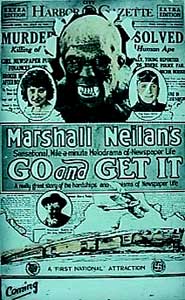 In the latter the ape is played by Duke Kahanamoku, an Olympics medalist from Hawaii, & an early promoter of sports surfing. He had hoped to break into the movies but was so personally exotic in his looks, & so dark-skinned, that the few roles he saw are largely insulting. In the latter the ape is played by Duke Kahanamoku, an Olympics medalist from Hawaii, & an early promoter of sports surfing. He had hoped to break into the movies but was so personally exotic in his looks, & so dark-skinned, that the few roles he saw are largely insulting.
We might expect, then, that the ape of Ingagi would have been recognized immediately as a cinematic cliche & nothing the least bit likely to be real. Instead, the constant exposure in novels, tales, & movies seems in some way to have convinced the plebian hordes that ape-men & giant killer apes & missing links were a dime a dozen somewhere out there in the world.
Building on just such ape films, Ingagi establishes a Cult of the Ape God to whom a Congolese tribe of amazonian women make sacrifices of native virgins. White hunters set out to kill the ape & rescue the girl.
Although the distributor was embarrassed & withdrew the film from circulation after the hoax was revealed, they'd nevertheless made a bundle of money off it. It is thought to have been the highest grossing film of the Depression. It was in consequence of the profitability of Inagaki that RKO Pictures was encouraged to film King Kong (1933).
Starring as the ape man was Charles Gemora who specialized in just such roles. He plays Zozo the lonely gorilla in The Circus Kid (1928) befriended after initial terror by circus boy Buddy (Frankie Darro, who grew up to make a series of comedy-mysteries with sidekick Mantan Morland).
Gemora was also the ape in Who Killed Doc Robbins? (1948), The Unholy Three (1930), Murders in the Rue Morgue (1932), Bing & Bob's The Road to Zanzibar (1941), Abbot & Costello's Africa Screams (1949), the Marx Brothers' At the Circus (1939), & other comedies & B thrillers, besides sculpturing the costume for Lon Chaney in The Hunchback of Notre Dame (1928).
Though the original Ingagi is today a little-seen relic without much reputation, its influence was long lasting, not only for inspiring King Kong, but for outraging the Hays Office which censored films. They added explicite new rules thanks to Ingagi banning sexual perversion from being depicted in any manner.
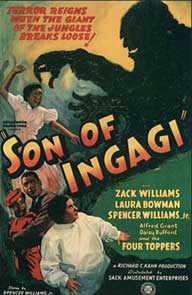 Son of Ingagi (1940) has only tangential relationship to the original, & it's greater claim to fame is that it is the first all-black-cast horror film. Son of Ingagi (1940) has only tangential relationship to the original, & it's greater claim to fame is that it is the first all-black-cast horror film.
That the director hoped to coattail the banned film suggests that it had been popular or well known in the black community, as Son of Ingagi was to play exclusively in black theaters.
This seems strange since the original is so racist, but at the height of the furor against the original Ingagi, none of the usual black intellectuals & organizations came forth to complain of it. It's nevertheless true that jungle pictures & especial Tarzan movies were very popular in the black theaters, & so must've been Ingagi.
Attractive newlyweds Bob & Eleanor Lindsay (Alfred Grant & Daisy Bufford) are stuck with a big reception party when they'd hoped to be alone. They'd faked their honeymoon vacation in order to return home & be alone immediately, but their party-lovin' buddies followed them.
The highlight of the party is a performance by the Four Toppers, a vocal harmony group very like the Delta Rhythm Boys or the Cats & the Fiddle. The four voices accompanied by guitar & bass do two numbers, "So Long Pal" & "You Drove the Groom Away."
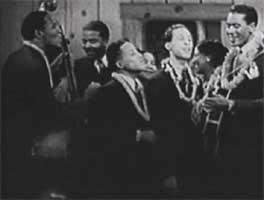 They're stunningly good & should've been more famous. They also appear in the excellent black-cast musicals Mystery of Swing (1940) & Murder with Music (1941). They're stunningly good & should've been more famous. They also appear in the excellent black-cast musicals Mystery of Swing (1940) & Murder with Music (1941).
They were only together a few years. They sometimes sang out front with Cee Pee Johnson's Orchestra, & two of their members, Steve Gibson & Jimmy Springs, were later in the more famous vocal group, the Five Red Caps.
A strange old lady is lurking around the house where the party is in full sway. This is Dr. Helen Jackson (Laura Bowman, who can also be seen in a couple of Oscar Micheaux films), whose behavior is decidedly odd.
The party is winding down when unexpectedly there's an exposion & fire a few blocks away at the foundary. Bob works at the foundary so he takes off to see if he is still going to have a job. Eleanor is left alone in the house & that's when the strange old lady doctor enters for a private talk.
Eleanor had been orphaned at ten months. The doctor knew her parents, & had secretly assisted in Eleanor's life at critical moments. Dr. Jackson had been a rival for the affections of Eleanor's father, & having lost at love, devoted herself thereafter to missionary work in Africa & then to medical science. She had always felt that Eleanor might have been her child had things gone a little differently.
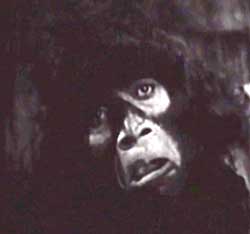 Zeno Jackson (Arthur Ray) is Dr. Jackson's criminal ne'er-do-well brother. He breaks into his sister's house & when caught demands half of her hidden fortune, gold she brought back with her from Africa. Zeno Jackson (Arthur Ray) is Dr. Jackson's criminal ne'er-do-well brother. He breaks into his sister's house & when caught demands half of her hidden fortune, gold she brought back with her from Africa.
Helen won't bow to her brother's demands nor even admit she has such a fortune. Instead, she calls forth through a secret door the ape-man N'Gina (Zack Williams), a hairy giant who protects Helen & is devoted to her. Zeno flees the house in terror of the monster his sister brought back with her from the Congo.
Helen Jackson has been experimenting with a miracle medicine which might benefit all humankind, but alas upon the hour of her success, the ape man she has cared for like a son gets into the concoction & becomes drunk & crazy. In the creature's altered frame of mind he attacks & kills Dr. Jackson, then withdraws into his secret basement lair to sleep it off.
The young couple soon learn they have inherited Dr. Jackson's house. They're due some good luck since Bob has been out of work since the foundary fire. They move in, unaware that an ape-man with childlike mind lurks beneath the floorboards & comes & goes secretly in the night.
Helen's brother returns by night to break into his late sister's basement to search of the hidden gold. He came armed with a gun, knowing of the ape man, who pathetically takes many bullets but can't be stopped. The ape kills the thief & drags the corpse up into the main part of the house, staggering & in pain.
He then tries to find the lady doctor he previous killed, as he's really not aware of what he's done, & he is used to having her put medicine & bandaids on his booboos. It's the young bride Eleanor he finds instead, for a classic "giant ape carries off girl" sequence, taking her into his basement lair.
The actors have been surprisingly good through all this, better at least than one expects from a silly ape man movie. There's a bit of comedy with the police detective (Jesse Graves) making sandwiches the sneaky ape steals. Obviously it's no a great movie yet there's effective-enough suspense when Bob & the detective are trying to resolve the murders & find out what happened to Helen.
The tragic-visaged ape make-up & costume for N'Gina is especially nicely done, on the cheap of course, but so much better than the usual rented gorilla suit one sees in old thrillers within this nutty subgenre of ape-in-the-basement movies.
In the end the poor monster is killed in a fire he accidently starts. Although the young married couple have lost the house they inherited, they did at least end up with the hidden gold, & their future is set. A happy ending for them at least. Too bad N'Gina couldn't've been sent back to the Congo instead of burnt up though.
copyright © by Paghat the Ratgirl
|
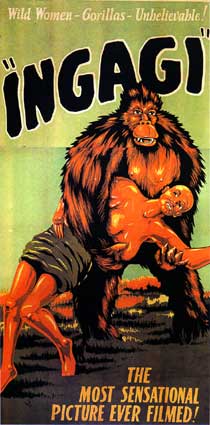

 The film remains famous as hoax, though it's hard to understand how anyone could've been so supremely guillible.
The film remains famous as hoax, though it's hard to understand how anyone could've been so supremely guillible. For gorillas rampaging in cities, we first had Poe's short story "The Murders in Rue Morgue," which inspired William Leroux's international bestselling novel Balaoo which was filmed as the twenty-minute Balaoo the Demon Baboon (Balaoo ou Des pas au plafond, 1913), instigating a slug of ape-kidnaps-girl movies.
For gorillas rampaging in cities, we first had Poe's short story "The Murders in Rue Morgue," which inspired William Leroux's international bestselling novel Balaoo which was filmed as the twenty-minute Balaoo the Demon Baboon (Balaoo ou Des pas au plafond, 1913), instigating a slug of ape-kidnaps-girl movies. In the latter the ape is played by Duke Kahanamoku, an Olympics medalist from Hawaii, & an early promoter of sports surfing. He had hoped to break into the movies but was so personally exotic in his looks, & so dark-skinned, that the few roles he saw are largely insulting.
In the latter the ape is played by Duke Kahanamoku, an Olympics medalist from Hawaii, & an early promoter of sports surfing. He had hoped to break into the movies but was so personally exotic in his looks, & so dark-skinned, that the few roles he saw are largely insulting.
 They're stunningly good & should've been more famous. They also appear in the excellent black-cast musicals Mystery of Swing (1940) & Murder with Music (1941).
They're stunningly good & should've been more famous. They also appear in the excellent black-cast musicals Mystery of Swing (1940) & Murder with Music (1941).